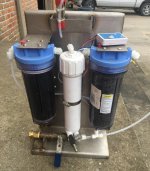^ I agree, but from a basic chemical point of view all softening does is replace the calcium with sodium, still just as much minerals in there, just a different kind. RO removes that mineral concentration.
I would not sweat lots of mixed bacteria, you need a eco system, not a monopoly, because single organism only will stink, either as it eats what its eating or as it dies and something eats it, Secrets in having a stable biological food chain in there that does not cause odour or eat the machine - eat you. The natural pond of some stone masons wet systems is probably a great place to find a balanced eco system of bugs to colanise your tank, add in the stone waste neutralizing the acid stagnant pools naturally collect from the air in sulfur or carbon compounds. Acidic liking bacteria tend to stink bad to us humans, there often the subset of groups that are the results of food decay, hence its a basic instinct thing. Alkaline living bacteria don't tend to smell to us humans in the same way which is a good thing as were kinda covered in them.
Adding a biocide that releases something toxic as it breaks down is a sure way to kill you not the smell for long too.


